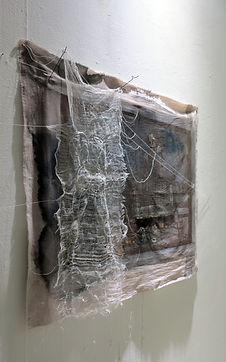Sue Clark
THE GODS OF PRETSHWANE
Marabi Girl
Marabi Girl [3] (2021) features the decaying hybrid of Kruger Park and Paul Kruger confronted by a part-female, part-plant form of medical gauze and thread. A ghost from Marabastad’s past, she heralds its vibrant multiculturalism before apartheid into the present with a renewed, organic connection to the earth.
[3] The word ‘Marabi’ describes a working-class culture that flourished in the slum yards of Gauteng during the 1930s. The name is considered to originate from Marabastad. Marabi music was often played in shebeens and accompanied by dancing. Marabi also implied a certain lifestyle. “Marabi love’ was illicit, a ‘marabi girl’ wanted a good time. But marabi meant more. It meant youth and modernity and freedom of the town. It meant freedom of towns not yet in the grip of t the state. It meant hope and ambition not yet crushed. (Ilife 1987:128). (https://repository.up.ac.za/bitstream/handle/2263/30278/02chapter2.pdf?sequence=3&isAllowed=y)

Marabi Girl 2021
Cyanotype, green tea, bleach, gauze and stitching, 65 x 40 cm


Process
The Kruger Park building statue hybrid drawing was transferred to architectural drafting film. White cotton fabric was coated with cyanotype chemicals and exposed to the sun to produce a blue image of the drawing. The cyanotype was then toned with green tea and turmeric. Highlights were added with soda ash, bleach, and smoke. The gauze figure was then superimposed to engage with Kruger.


Cyanotype negatives: Images drawn on transparant drafting film with black ink and markers
Treated fabric being exposed in sun


.jpg)
Experimental exposures

